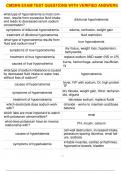CMSRN EXAM TEST QUESTIONS WITH VERIFIED ANSWERS
what type of hyponatremia is most com-
mon, results from excessive fluid intake
dilutional hypotnatremia
and leads to decreased serum sodium
concentration?
symptoms of diltuional hyponatremia edema, confusion, weight gain
treatment of dilutional hyponatremia fluid restriction
what type of hyponatremia results from
true hyponatremia
fluid and sodium loss?
dry tissue, weight loss, hypotension,
symptoms of true hyponatremia
tachycardia
treatment of true hyponatremia replace sodium AND water (NS or LR)
burns, hemorrhage, adrenal insufficien-
causes of true hyponatremia
cy
what type of sodium imbalance is caused
by decreased fluid intake or water loss hypernatremia
without loss of sodium?
fever, IVF with sodium, DI, high protein
causes of hypernatremia
TF
dry tissues, weight gain, thirst, tachycar-
symptoms of hypernatremia
dia, oliguria
treatment of hypernatremia decrease sodium, replace fluids
which electrolyte does sodium work chloride - works to maintain acid/base
with? balance
which labs are most important to watch
renal
with potassium abnormalities?
what does potassium have an inverse
PH, insulin, calcium
relationship with?
cell wall destruction, increased intake,
causes of hyperkalemia potassium sparing diuretics, renal fail-
ure, acidosis
irritable muscles, cardiac arrhythmias,
symptoms of hyperkalemia
hyperactive bowels, bladder
, limit intake, kaexylate, calcium glu-
treatment of hyperkalemia
conate, IV glucose and insulin, dialysis
what electrolyte imbalance should you
avoid green leafy vegetables and citrus hyperkalemia
fruits?
what electrolyte are avocado, dried
potassium
fruits, and potato skins high in?
vomiting, diarrhea, DKA, prolonged NG
causes of hypokalemia suction, burns, potassium wasting diuret-
ics
muscle flaccidity and weakness, con-
symptoms of hypokalemia stipation, alkalosis, shallow respirations,
cardiac arrest
potassium supplements, monitor magne-
treatment for hypokalemia
sium levels
normal calcium level 9-10.5
where is calcium stored? bones
what vitamin is important for calcium ab-
Vitamin D
sorption
what does calcium have an inverse rela-
phosphorous
tionship with?
which electrolyte imbalance increases
hypocalcemia
bleeding risk?
cancer, bone mets, hyperparathyroidism,
causes for hypercalcemia excessive vitamin D, thiazide diuretics,
parathyroid tumor
sedation, lethargy, hypoactive reflexes,
slurred speech, impaired memory (de-
symptoms of hypercalcemia
creased LOC/CNS sympstoms), renal
stones
decrease intake, encourage fluids, loop
treatment for hypercalcemia
diuretics, phosphate administration
causes of hypocalcemia
, decreased intake, decreased vitamin D,
increased phosphate levels, renal dis-
ease, pacreatitis, alcoholism, pregnancy
chvosteks, trousseaus, laryngospasm,
symptoms of hypocalcemia
tingling in fingers/toes/lips, coagulopathy
increased intake, vitamin D, IV calcium
treatment of hypocalcemia
gluconate, phosphate binding antacids
sign of hypocalcemia that causes twitch-
chvosteks sign
ing of face if you tap the front of the ear?
sign of hypocalcemia that causes carpal
trousseaus sign
tunnel/turning in of hands?
normal level of phosphate 3-4.5
symptoms of this electrolyte imbalance
are opposite of calcium since it has an phosphate
inverse relationship
Normal level of magnesium 1.3-2.1
Normal level of sodium 135-145
normal level of potassium 3.5-5.0 mEq/L
poor renal excretion, muscular depres-
symptoms of hypermagnesemia
sion
Hyperactive deep tissue reflexes,
symptoms of hypomagnesemia tremors, seizures, cardiac arrhythmia,
confusion (resembles hypocalcemia)
treatment for hypermagnesemia calcium gluconate
what is serum osmolality? how thick solution is
what does it mean if serum osmolality is
the patient is dry
high?
what type of solution is NS, LR? isotonic
expands blood volume
increases blood pressure if dehydrated
what does an isotonic solution do?
has same osmolarity as our cells
can cause electrolyte increase




